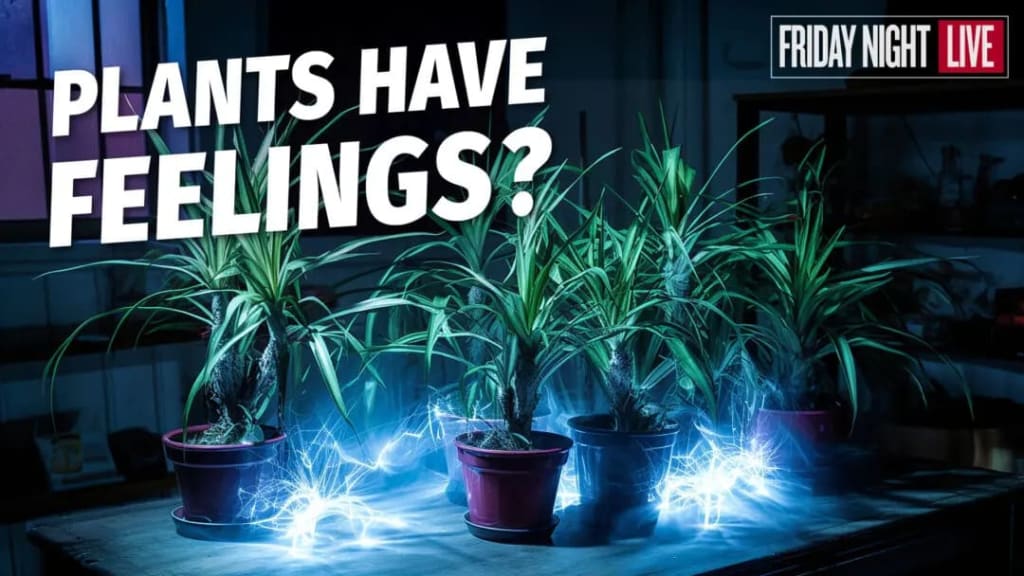The feeling of pain & stress | Research proves that plants have feelings
Examine whether plants possess advanced sensory systems that enable them to respond to threats or variations in their environment.

Explanation of how plants have feelings: The feelings of pain and stress:-
Plants allow their intricate sensory systems to detect hazards or other modifications to respond to their environment. Plants lack the major senses of sight, hearing, and a tongue to taste like humans till today, but on the other hand the feeling from their outer core can help them in many tasks like real feelings. It's not just rain and storms that plants are conscious of. Yet they also have emotions and can respond accordingly.
Plants have a complex sensory system that helps them perceive and respond to their environment. They use specialized cells called trichomes to detect light, temperature, humidity, and touch. Trichomes also contain chemicals that can help plants defend themselves against predators or attract beneficial insects.
Furthermore, plants have specialized cells called guard cells that regulate the opening of the stomata, which allow plants to breathe and detect changes in carbon dioxide levels. Overall, plants have an intricate sensory system that allows them to adapt to their changing surroundings without traditional senses like sight, hearing, and smell.
Discover the important topic at hand and explore the basic causes of these fantastic happenings. Our team professionally guides you to the fascinating rise and dawn of strange information. Let's step up to an advanced level of expertise.
Are you looking for wonderous, strange, and mysterious content…?
Rise TV’s series, Edge of Wonder, showcases the most fascinating topics from our famous research collection. Interesting?
Why not become a subscriber and join us on this strange journey?
The major difference in feelings between plants and animals:-
Animals possess neurons that transmit sensory information to their central nervous system, just like humans. If the mind perceives these emotions as negative and harmful, it sends a warning signal back to the source, prompting us to react and preventing further pain. Similarly, animals rely on their memories to avoid future trauma. Interestingly, unlike humans, animals do not release adrenaline when recalling past injuries.
Plants do not have a central neural system, which means they don't process stimuli like animals do. However, plants can still respond to negative stimuli by showing signs of sensitivity. For example, when you touch the leaves of the Mimosa pudica plant, they will close. Similarly, if you prune a shrub, it will create a protective layer over the wound and encourage new growth below the cut.
The main difference between plant and animal memory is that animals have a central nervous system, which processes and stores memories, while plants do not. Animals have neurons that convey sensory information to their brains, allowing them to remember past experiences and learn from those memories. On the other hand, plants lack a central neural system, so they do not process stimuli in the same manner. However, plants do have feelings and respond to adverse or unfavorable stimuli, show signs of memory retention, and can adapt to their environment.
Plants can communicate with each other:-
Similar to other living beings, certain plants engage in communication through sound. Sound refers to vibrations in the air that can be produced by cells in plants and detected by plant fibers.
A recent study of plant communication discovered that certain plants are capable of emitting high-frequency sound waves. For instance, tomato and tobacco vines produce sounds when experiencing drought or when their leaves are plucked. Additionally, plants have feelings and the ability to perceive sounds and act as attentive listeners.
Pea plants exhibit a tendency to grow their roots towards the sound of water movement, even if the sound is recorded and no actual water is present. Similarly, primrose flowers produce delicious syrup when they are exposed to the sound of buzzing bees, whether it is artificially created or occurs naturally. This demonstrates that plants have the ability to listen and communicate with each other through their profound emotions.
In addition to sound, plants also communicate with each other through chemical signals. For example, when a plant is under attack by a pest or pathogen, it releases chemicals that attract other nearby plants of the same species to help them defend against the aggressor. These chemical signals can travel through the air or be transmitted through the soil, allowing plants to form a collective response to threats.
The feelings of smell and taste owned by plants:-
Plants create their own nourishment through photosynthesis, so they don't require the sense of taste. Nevertheless, taste and smell are closely connected as they both depend on chemical detection through specific receptors. Plants employ similar mechanisms for various important functions, such as finding nutrients in the soil and avoiding unfavorable conditions for root growth.
Interestingly, plants can also sense their surroundings and identify their neighboring plants. For instance, the dodder vine, known to tomato farmers, can detect airborne compounds and grow towards its host.
Underground, plants also communicate with each other. Through extensive mycorrhizal networks, tree roots connect with fungi. Suzanne Simard's research revealed that nearly every tree in the forest is part of this network. Within this network, nine trees exchange information about carbon dioxide, water, nutrients, and even warning signals.
The feelings of touch and response of plants:-
Different types of plants have different ways of adapting to their environment. For example, climbing plants like sweetpeas rely on support structures to help them grow vertically. On the other hand, plants like Arabidopsis become stressed when they are touched, which can hinder their growth.
Many organisms, including plants, use their root systems to navigate through the soil, avoiding obstacles like rocks and toxins. Some plants even have specialized leaves that can detect and respond to specific stimuli. For instance, sensitive plants like Mimosa pudica have stems that fold inward when touched, providing protection against potential harm.
“They concluded that the inner layers are under compressive forces while the outer layer is under tension.” said Dr. Johnson.
The Venus flytrap is another great example. It has leaves that have been modified to catch insects, while disregarding any other debris that may fall in. These modified leaves have tiny trigger hairs on their outer layer. When these hairs are touched, it triggers a substance called a "timer" within the leaf.
The evolutionary advantage of the plant's ability to protect itself from damage is to ensure its survival and reproductive success. By sensing and responding to touch, plants can safeguard their delicate tissues and organs from harm or predation. This ability allows plants to avoid damage, maintain their health, and continue photosynthesizing and reproducing, thus perpetuating their species.
The feeling of pain and stress is also owned by plants:-
Plants, just like humans and animals, can experience stress and become overwhelmed. This leads us to wonder: How can we help plants relax? In 1847, WF Clemens proposed that plants could be anesthetized and lose their sensitivity, similar to humans and animals.
What's even more fascinating is that when plants are injured or attacked by pathogens, they produce their own anesthetic substances to minimize the harm caused.
Plants can experience various types of stress, such as environmental stress caused by extreme temperatures, drought, or pollution, as well as mechanical stress caused by physical injury or improper pruning. Additionally, plants can experience emotional stress caused by competition with other organisms for resources or attack by pests or diseases.
Concluding thoughts and a reference by Dr. Kim Johnson:-
- The scientific community has engaged in thought-provoking debates surrounding the correlation between plants and the experience of pain and stress, fueling further research in this area.
- Recent research exploring the complex ways in which plants respond to their environment has revealed compelling evidence that plants have advanced sensory systems, which challenges the conventional belief that they merely exist passively.
- The ongoing debate aside, recognizing the possibility of complex plant behaviors enhances our comprehension of the intricate ecosystem on Earth, highlighting the interdependence of all living beings.
- The advancement of scientific research leads us to reevaluate the limits of consciousness and compassion in nature, as we ponder the possibility of plants experiencing emotions.
- Dr. Kim Johnson explains that plants undergo continuous environmental stress. So, they are also evident through their ability to adapt and alter their physical structure in response to these stresses.
About the Creator
Gutavo Martini
A fabulous social being, dedicated to digital marketing, adeptly intelligent members with fantastic individuals whose profound concepts fuel the genius body.
Enjoyed the story? Support the Creator.
Subscribe for free to receive all their stories in your feed. You could also pledge your support or give them a one-off tip, letting them know you appreciate their work.






Comments
There are no comments for this story
Be the first to respond and start the conversation.